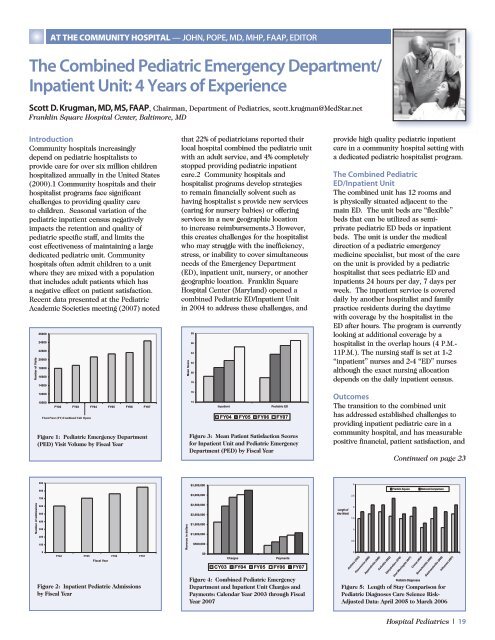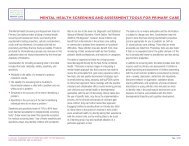Susan Wu, MD, FAAP, Editor - American Academy of Pediatrics
Susan Wu, MD, FAAP, Editor - American Academy of Pediatrics
Susan Wu, MD, FAAP, Editor - American Academy of Pediatrics
You also want an ePaper? Increase the reach of your titles
YUMPU automatically turns print PDFs into web optimized ePapers that Google loves.
at the CommUNitY hoSPitaL — JOHN, POPE, <strong>MD</strong>, MHP, <strong>FAAP</strong>, EDITOR<br />
The Combined Pediatric Emergency Department/<br />
Inpatient Unit: 4 Years <strong>of</strong> Experience<br />
Scott D. Krugman, <strong>MD</strong>, MS, <strong>FAAP</strong>, Chairman, Department <strong>of</strong> <strong>Pediatrics</strong>, scott.krugman@MedStar.net<br />
Franklin Square Hospital Center, Baltimore, <strong>MD</strong><br />
Introduction<br />
Community hospitals increasingly<br />
depend on pediatric hospitalists to<br />
provide care for over six million children<br />
hospitalized annually in the United States<br />
(2000).1 Community hospitals and their<br />
hospitalist programs face significant<br />
challenges to providing quality care<br />
to children. Seasonal variation <strong>of</strong> the<br />
pediatric inpatient census negatively<br />
impacts the retention and quality <strong>of</strong><br />
pediatric specific staff, and limits the<br />
cost effectiveness <strong>of</strong> maintaining a large<br />
dedicated pediatric unit. Community<br />
hospitals <strong>of</strong>ten admit children to a unit<br />
where they are mixed with a population<br />
that includes adult patients which has<br />
a negative effect on patient satisfaction.<br />
Recent data presented at the Pediatric<br />
Academic Societies meeting (2007) noted<br />
Figure 1: Pediatric Emergency Department (PED) Visit Vo lume by Fiscal Year<br />
Number <strong>of</strong> Visits<br />
26000<br />
24000<br />
22000<br />
20000<br />
18000<br />
16000<br />
14000<br />
12000<br />
10000<br />
FY02 FY03 FY04 FY05 FY06 FY07<br />
Fiscal Ye ar (FY) Combined Unit Opens<br />
Figure 1: Pediatric Emergency Department<br />
(PED) Visit Volume by Fiscal Year<br />
Figure 2: Inpatient Pediatric Admissions by Fiscal Ye ar<br />
Number <strong>of</strong> admissions<br />
900<br />
800<br />
700<br />
600<br />
500<br />
400<br />
300<br />
200<br />
100<br />
0<br />
FY04 FY05 FY06 FY07<br />
Fiscal Year<br />
Figure 2: Inpatient Pediatric Admissions<br />
by Fiscal Year<br />
Figure 4: Combined Pediatric Emergency Department and Inpatient Unit Charges and Payments: Calendar<br />
Year 2003 through Fiscal Year 2007<br />
Revenue in dollars<br />
that 22% <strong>of</strong> pediatricians reported their<br />
local hospital combined the pediatric unit<br />
with an adult service, and 4% completely<br />
stopped providing pediatric inpatient<br />
care.2 Community hospitals and<br />
hospitalist programs develop strategies<br />
to remain financially solvent such as<br />
having hospitalist s provide new services<br />
(caring for nursery babies) or <strong>of</strong>fering<br />
services in a new geographic location<br />
to increase reimbursements.3 However,<br />
this creates challenges for the hospitalist<br />
who may struggle with the inefficiency,<br />
stress, or inability to cover simultaneous<br />
needs <strong>of</strong> the Emergency Department<br />
(ED), inpatient unit, nursery, or another<br />
geographic location. Franklin Square<br />
Hospital Center (Maryland) opened a<br />
combined Pediatric ED/Inpatient Unit<br />
in 2004 to address these challenges, and<br />
Figure 3: Mean Patient Satisfaction Scores for Inpatient Unit and Pediatric Emergency Department (PED)<br />
by Fiscal Year<br />
Mean Score<br />
$3,500,000<br />
Figure 4: Combined Pediatric Emergency Department and Inpatient Unit Charges and Payments: Calendar<br />
Ye ar 2003 through Fiscal Ye ar 2007<br />
$3,000,000<br />
$3,500,000<br />
$2,500,000<br />
$3,000,000<br />
$2,000,000 $2,500,000<br />
$1,500,000 $2,000,000<br />
$1,500,000<br />
$1,000,000<br />
Revenue in dollars<br />
88<br />
86<br />
84<br />
82<br />
80<br />
78<br />
76<br />
74<br />
$1,000,000<br />
$500,000<br />
$500,000<br />
$0<br />
$0<br />
Inpatient<br />
Charges<br />
Charges<br />
Pediatric<br />
ED<br />
FY04 FY05 FY06 FY07<br />
Figure 3: Mean Patient satisfaction scores<br />
for Inpatient Unit and Pediatric Emergency<br />
Department (PED) by Fiscal Year<br />
Payments<br />
Payments<br />
CY03 CY03 FY04 FY04 FY05 FY06 FY06 FY07 FY07<br />
Figure 4: combined Pediatric Emergency<br />
Department and Inpatient Unit charges and<br />
Payments: calendar Year 2003 through Fiscal<br />
Year 2007<br />
provide high quality pediatric inpatient<br />
care in a community hospital setting with<br />
a dedicated pediatric hospitalist program.<br />
The Combined Pediatric<br />
ED/Inpatient Unit<br />
The combined unit has 12 rooms and<br />
is physically situated adjacent to the<br />
main ED. The unit beds are “flexible”<br />
beds that can be utilized as semiprivate<br />
pediatric ED beds or inpatient<br />
beds. The unit is under the medical<br />
direction <strong>of</strong> a pediatric emergency<br />
medicine specialist, but most <strong>of</strong> the care<br />
on the unit is provided by a pediatric<br />
hospitalist that sees pediatric ED and<br />
inpatients 24 hours per day, 7 days per<br />
week. The inpatient service is covered<br />
daily by another hospitalist and family<br />
practice residents during the daytime<br />
with coverage by the hospitalist in the<br />
ED after hours. The program is currently<br />
looking at additional coverage by a<br />
hospitalist in the overlap hours (4 P.M.-<br />
11P.M.). The nursing staff is set at 1-2<br />
“inpatient” nurses and 2-4 “ED” nurses<br />
although the exact nursing allocation<br />
depends on the daily inpatient census.<br />
Outcomes<br />
The transition to the combined unit<br />
has addressed established challenges to<br />
providing inpatient pediatric care in a<br />
community hospital, and has measurable<br />
positive financial, patient satisfaction, and<br />
Figure 5: Length <strong>of</strong> Stay Comparison for Pediatric Diagnoses CareScience Risk-Adjusted Data: April 2005 to<br />
March 2006<br />
Length <strong>of</strong><br />
stay (days)<br />
3<br />
2.5<br />
2<br />
1.5<br />
1<br />
0.5<br />
0<br />
Asthma (493)<br />
Pneumonia (486)<br />
Appendicitis (540)<br />
Cellulitis (682)<br />
Continued on page 23<br />
Franklin Square National Comparison<br />
Dehydration (276)<br />
Viral Meningitis (047)<br />
Croup (464)<br />
Pediatric Diagnoses<br />
Bronchiolitis (466)<br />
Gastroenteritis (008)<br />
Influenza (487)<br />
Figure 5: Length <strong>of</strong> stay comparison for<br />
Pediatric Diagnoses care science risk-<br />
Adjusted Data: April 2005 to March 2006<br />
Hospital <strong>Pediatrics</strong> | 19



